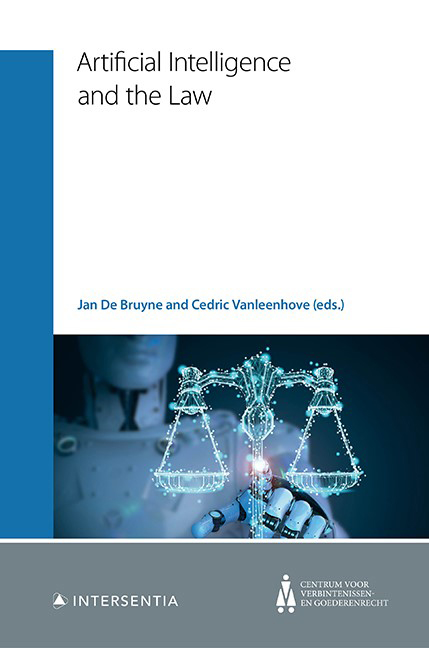Book contents
- Frontmatter
- Contents
- Foreword
- Contributing Authors
- Chapter 1 Basic Concepts of AI for Legal Scholars
- Chapter 2 Different Models of Innovation and Their Relation to Law
- Chapter 3 Setting the Scene: On AI Ethics and Regulation
- Chapter 4 Quantitative Legal Prediction: the Future of Dispute Resolution?
- Chapter 5 AI Arbitrators … ‘Does Not Compute’
- Chapter 6 AI through a Human Rights Lens. The Role of Human Rights in Fulfilling AI’s Potential
- Chapter 7 Killer Robots: Lethal Autonomous Weapons and International Law
- Chapter 8 AI and Data Protection: the Case of Smart Home Assistants
- Chapter 9 AI and IP: a Tale of Two Acronyms
- Chapter 10 Tax and Robots
- Chapter 11 Robotisation and Labour Law. The Dark Factory: the Dark Side of Work?
- Chapter 12 The Hypothesis of Technological Unemployment Caused by AI-Driven Automation and its Impact on Social Security Law
- Chapter 13 AI in Belgian Contract Law: Disruptive Challenge or Business as Usual?
- Chapter 14 Tort Law and Damage Caused by AI Systems
- Chapter 15 Insurance Underwriting on the Basis of Telematics: Segmentation and Profiling
- Chapter 16 AI and Creditworthiness Assessments: the Tale of Credit Scoring and Consumer Protection. A Story with a Happy Ending?
- Chapter 17 AI and the Consumer
- Chapter 18 Robots and AI in the Healthcare Sector: Potential Existing Legal Safeguards Against a(n) (Un)justified Fear for ‘Dehumanisation’ of the Physician-Patient Relationship
Chapter 8 - AI and Data Protection: the Case of Smart Home Assistants
Published online by Cambridge University Press: 26 May 2021
- Frontmatter
- Contents
- Foreword
- Contributing Authors
- Chapter 1 Basic Concepts of AI for Legal Scholars
- Chapter 2 Different Models of Innovation and Their Relation to Law
- Chapter 3 Setting the Scene: On AI Ethics and Regulation
- Chapter 4 Quantitative Legal Prediction: the Future of Dispute Resolution?
- Chapter 5 AI Arbitrators … ‘Does Not Compute’
- Chapter 6 AI through a Human Rights Lens. The Role of Human Rights in Fulfilling AI’s Potential
- Chapter 7 Killer Robots: Lethal Autonomous Weapons and International Law
- Chapter 8 AI and Data Protection: the Case of Smart Home Assistants
- Chapter 9 AI and IP: a Tale of Two Acronyms
- Chapter 10 Tax and Robots
- Chapter 11 Robotisation and Labour Law. The Dark Factory: the Dark Side of Work?
- Chapter 12 The Hypothesis of Technological Unemployment Caused by AI-Driven Automation and its Impact on Social Security Law
- Chapter 13 AI in Belgian Contract Law: Disruptive Challenge or Business as Usual?
- Chapter 14 Tort Law and Damage Caused by AI Systems
- Chapter 15 Insurance Underwriting on the Basis of Telematics: Segmentation and Profiling
- Chapter 16 AI and Creditworthiness Assessments: the Tale of Credit Scoring and Consumer Protection. A Story with a Happy Ending?
- Chapter 17 AI and the Consumer
- Chapter 18 Robots and AI in the Healthcare Sector: Potential Existing Legal Safeguards Against a(n) (Un)justified Fear for ‘Dehumanisation’ of the Physician-Patient Relationship
Summary
INTRODUCTION
1. Currently, economic actors do not only track online behaviour of consumers but also gather information about the offline world through domestic appliances that are connected to the internet – also known as the ‘internet of things’ or IoT. The information collected can range from objective facts, such as the ambient temperature, to very personal data concerning its users. This contribution focuses on one specific application of AI in a domestic IoT setting: smart home assistants (SHAs).
2. Smart home assistants can be approached from two angles. First, there is the futurist point of view. According to this viewpoint, a technology can only be called a ‘smart home assistant’ if it pulls together data from different devices in the home, builds a real-time profile of the conditions in the home, and takes actions according to a combination of such analyses and commands issued by the home owner. However, when observing the real-life landscape it is clear that we are still far-removed from a widespread implementation of such SHAs. Although consumers increasingly own individual smart devices and household appliances, the only IoT devices that manage to achieve a considerable uptake percentage are home assistants, smart speakers and smart watches. Furthermore, there is scepticism among consumers regarding the need for a central control system vis-à-vis individual controls by different devices and apps, which is possibly explained by the lack of trust consumers have in the security of these devices.
3. This contribution therefore takes a realistic angle and chooses to investigate the currently most widely used SHAs: the combination of a smart speaker with a virtual personal assistant (VPA). Around 24% of the population in the United States now have at least one such a device and adopters on average have 2.6 such devices in their home. A recent UK survey revealed that 22% of those interviewed owned such a device. In the Netherlands around 19% of the population is estimated to have a smart speaker in their household. For Belgium, no numbers were found.
- Type
- Chapter
- Information
- Artificial Intelligence and the Law , pp. 173 - 206Publisher: IntersentiaPrint publication year: 2021



